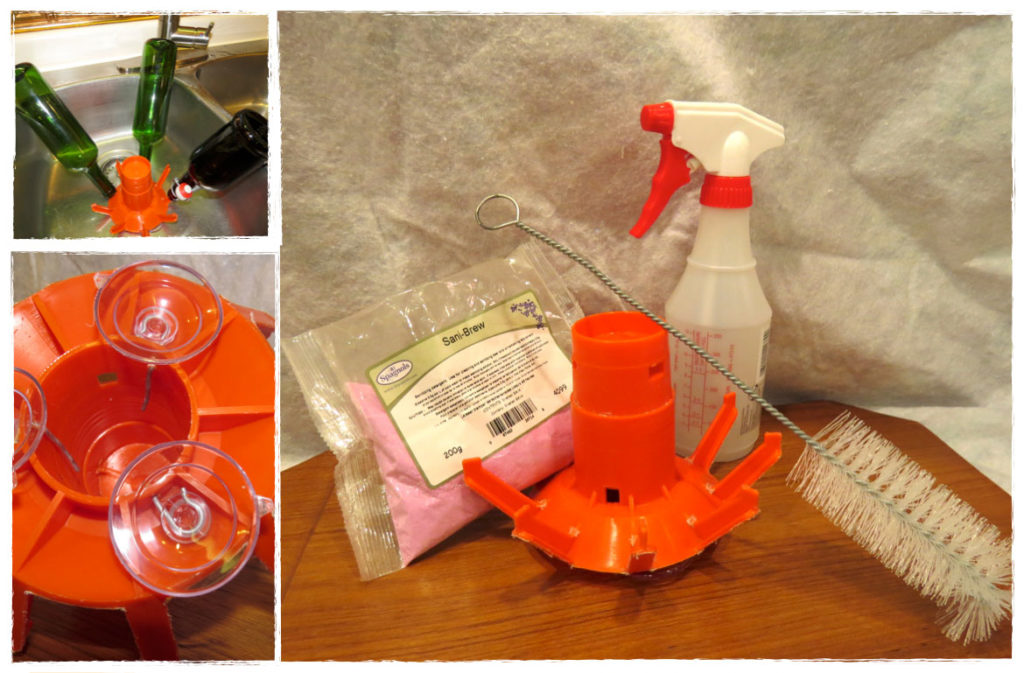Bottle Care 101
Check Out Our Bottle Cleaning Kits – Exclusively at Flying Fish Winery!

Proper Bottle Cleaning
Here are step-by-step instructions on exactly how to clean your bottles for future use:
- Rinse out your empty bottle with clean water.
- Spray solution (see premixing solution below) into rinsed bottle.
- Stand upside down on the bottle finger stand until dry.
- Store upside down in your box until ready to bottle again!
To mix your Sani-Brew Solution: measure 1/2 tsp of Sani-Brew into a spray bottle, fill to the top ring with warm water, attach the lid, and shake. Our cleaning kit also includes a bottle brush, perfect for beer and cider bottles, as well as getting stains out of your bottles!
Ensure you have a clean bottle every time in less than a minute!
Bottle Cleaning 101
While we call it Bottle Care 101, we might as well just call it Bottle Cleaning 101 because cleaning bottles is probably the most important aspect of taking care of your bottles. Wine is all about a careful balance of notes and flavours; all of which go out the window when you start with a dirty bottle.
So when do you clean your bottles?
The best time to clean your wine or beer bottles is as soon as they’re empty. Don’t put them away to clean later in a batch; do them that night. The last thing you want is to leave that little bit of residue on the inside of your bottles.
The biggest reason you don’t ever store your bottles without cleaning them is mould. All the sugars in your wine not only attract insects, but also provide a medium for mould spores. Mould spores can spread through the air and are very dangerous when inhaled. It’s important to do all you can to prevent mould from spreading from your bottles to anyone else’s.
If we see signs of heavy mould contamination in your bottles, we will ask you to remove them from our premises. We will not risk cross-contamination due to mouldy bottles on site.
How DON’T you clean your bottles?
For the most part, it doesn’t really matter how you clean the outside of your bottles. So long as there’s no mould there, and they aren’t sticky, they’re probably fine. What matters is how you clean the inside of your bottles. More to the point, what matters is what you don’t do.
The first rule of cleaning bottles is never ever use any form of soap or detergent to clean the inside. This means don’t run them through the dishwasher or dunk them in the sink. Detergent leaves a residue that is very difficult to get out. The only bubbles you want in your wine are the sparkling ones!
Many people like to put homebrew beer and cider in plastic bottles rather than glass ones. They work very well but there are a few things to watch out for; the most important being never put them in the dishwasher. Heat damages and weakens plastic bottles, causing them to explode when filled on the machine.
Don’t try to soak the label off a wine bottle; it may get rid of the paper but it won’t do anything about the glue. Instead, let the bottle dry overnight and then fill it with hot water. The heat will soften the glue, so you can remove it along with the label. For a good rule of thumb: the longer you age the wine, the longer you have to leave the hot water in the bottle to soften the glue.
So how DO you clean your bottles?
Now that you know what not to do, it’s time to talk about what you should do. There are two aspects to the bottle-cleaning process: cleaning and sanitizing. The thing to remember about cleaning is that it means getting everything out of the bottle. You don’t want any kind of residue left inside, whether it be from the previous contents or a cleaning agent.
Then, once the surface is clean you sanitize. The purpose of sanitizing is to kill bacteria and microbes that may remain inside the bottle after cleaning. This provides a sterile environment for your beer, wine, or cider to age without contaminants.
Once you clean and sanitize your bottles, it’s important to let them air dry. Do not wipe them dry as that can transfer microorganisms or other contaminants from the cloth to the bottle. Air drying a bottle upside down allows moisture to drip down out of the bottle and evaporate. Once the bottle is dry, you’re ready to put it away for the next batch.
If you rinse out and properly clean your bottles once they’re empty they can last for years, especially the glass ones. Don’t let the residue dry inside the bottle, rinse it out as soon as it’s empty. This not only makes cleaning much easier, but also helps ensure that your bottles are thoroughly cleaned the first time.